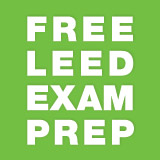
Free LEED Exam Prep - Get LEED Certified Training
GreenCE’s mission is to support the necessary transition to a sustainable built environment by empowering design professionals to address the environmental, economic, and social impacts of buildings. GreenCE’s course catalog includes LEED exam preparation, continuing education to maintain your AIA or LEED credential, as well as specialty education focused on topics such as ADA/Barrier-Free requirements. We are committed to designing the highest quality continuing education programs in the construction industry.
The Free LEED Exam Prep course will help you pass the LEED exam the first time. The LEED Green Associate exam tests your knowledge about LEED certification. The free LEED training course will provide you with 10 video modules that explore credit categories, the USGBC, and strategies to pass the exam. The online class includes a free LEED Study Guide, free practice exams, Study Sheets, and 8 hour audio book. Get LEED certified projects after taking this online course. Please share this free resource with your friends, collogues, and co-workers by using the social media share options below.
The Free LEED Exam Prep course is composed of 10 modules. The modules include an Introduction, the LEED credit categories, and a Conclusion with exam study strategies. Each module is comprised of high-definition video, voice over, animation, music. Participants are encouraged to view all modules if they are new to the LEED rating system. Also, since the modules are video based, participants should utilize high speed internet. The Free LEED Exam Prep Course modules can be accessed from the Course tab above. Students can watch the video modules at their leisure 24/7. Get LEED certified projects and obtain your credential today.
LEED Exam Study Guide
The LEED GA Exam can be difficult to pass. Our team has created a free LEED Study Guide to help you pass the exam. The Exam Study Guide contains information about LEED certification, Integrative Strategies, Location and Transportation, Sustainable Sites, Water Efficiency, Energy and Atmosphere, Materials and Resources, Indoor Environmental Quality, and Project Surroundings and Public Outreach.
Free LEED Practice Questions And Exams
Our free LEED practice questions simulate the actual exam and will help you prepare. The LEED practice questions have been developed by green building experts to replicate what you will experience for the exam. We have provided over 300 free LEED practice questions for you.
LEED Exam Study Sheets
The LEED study sheets contain the major Category and Credit Names, Intent, Credit Requirements, and Codes and Standards. Participants should utilize the LEED Study Sheets in conjunction with the LEED Exam Study Guide to fully prepare for the exam. The LEED training materials provided should ensure you have everything you need for exam preparation.
What Is On The LEED Exam?
LEED exams are created by subject matter experts from around the world. The test specifications are subject to rigorous validation by subject matter experts, which ensures that the exam is valid, measuring what it is intended to measure. Once exams are launched the exam questions are regularly monitored to ensure continued reliability. The LEED exam assess candidates’ abilities at three hierarchical cognitive levels: Recall, Application and Analysis.
Recall Items: These items assess a candidate’s ability to recall factual material that is presented in a similar context to the exam references.
Application Items: These items provide the candidate with a novel problem or scenario that the candidate can solve using familiar principles or procedures described in the exam references.
Analysis Items: These items assess a candidate’s ability to break the problem down into its components to create a solution. The candidate must not only recognize the different elements of the problem, but must also evaluate the relationship or interactions of these elements.
The LEED Green Associate exam tests a candidate’s general knowledge of green building practices for both commercial and residential spaces and both new construction and existing buildings as well as how to support other professionals working on LEED projects. The exam tests candidates about Knowledge Domains.
1) LEED Process (16 Questions)
- Organization fundamentals (role of USGBC/GBCI)
- Structure of LEED rating systems (credit categories; prerequisites; Minimum Program Requirements for LEED Certification)
- Scope of each LEED rating system (rating system families BD+C, ID+C, O+M, ND, Homes)
- LEED development process (stakeholder and volunteer involvement; rating system updates/evolution)
- Credit categories (goals and objectives of each LT, SS, WE, EA, MR, EQ, IN, RP synergies)
- Impact categories
- LEED certification process (Certified, Silver, Gold, Platinum]; LEED Scorecard; LEED Interpretations; Addenda; LEED Online; Project Registration)
- Other rating systems
2) Integrative Strategies (8 Questions)
- Integrative process
- Integrative project team members (architect; engineer; landscape architect; civil engineer; contractor; facility manager, etc.)
- Standards that support LEED (breadth not depth of ASHRAE; SMACNA guidelines; Green Seal; Energy STAR®; HERs; Reference Standards listed in ACPs, etc.)
3) Location and Transportation (7 Questions)
- Site selection (targeting sites in previously developed and brownfields/high- priority designation area; avoiding sensitive habitat; located in areas with existing infrastructure and nearby uses; reduction in parking footprint)
- Alternative transportation (type, access and quality; infrastructure and design)
3) Sustainable Sites (7 Questions)
- Site assessment (environmental assessment; human impact)
- Site design and development (construction activity pollution prevention; habitat conservation and restoration; exterior open space; rainwater management; exterior lighting; heat island reduction)
4) Water Efficiency (9 Questions)
- Outdoor water use (use of graywater/rainwater in irrigation; use of native and adaptive species)
- Indoor water use (concepts of low flow/waterless fixtures; water-efficient appliances; types and quality)
- Water performance management (e.g., measurement and monitoring)
5) Energy and Atmosphere (10 Questions)
- Building loads (building components; space usage [private office, individual space, shared multi-occupant spaces])
- Energy efficiency (basic concepts of design; operational energy efficiency; commissioning; energy auditing)
- Alternative and renewable energy practices (demand response; renewable energy; green power; carbon off sets)
- Energy performance management (energy use measurement and monitoring; building automation controls/advanced energy metering; operations and management; benchmarking; Energy Star)
- Environmental concerns (sources and energy resources; greenhouse gases; global warming potential; resource depletion; ozone depletion)
4) Materials and Resources (9 Questions)
- Reuse (building reuse; material reuse; interior reuse; furniture reuse)
- Life-cycle impacts (concept of life-cycle assessment; material attributes; human and ecological health impacts; design for flexibility)
- Waste (construction and demolition; maintenance and renovation; operations and ongoing; waste management plan)
- Purchasing and declarations (purchasing policies and plans; environmental preferable purchasing (EPP); building product disclosure and optimization [i.e., raw materials sourcing, material ingredients, environmental product disclosure])
5) Indoor Environmental Quality (8 Questions)
- Indoor air quality (ventilation levels; tobacco smoke control; management of and improvements to indoor air quality; low-emitting materials; green cleaning)
- Lighting (electric lighting quality; daylight)
- Sound (acoustics)
- Occupant comfort, health, and satisfaction (controllability of systems; thermal comfort design; quality of views; assessment/survey)
6) Project Surroundings and Public Outreach (11 Questions)
- Environmental impacts of the built environment (energy and resource use in conventional buildings; necessity of green buildings; environmental externalities; triple bottom line)
- Codes (relationship between LEED and codes [building, plumbing, electrical, mechanical, re protection]; green building codes)
- Values of sustainable design (energy savings over time; healthier occupants; money-saving incentives; costs [hard costs, soft costs]; life cycle)
- Regional design (regional green design and construction measures as appropriate; regional emphasis should be placed in Sustainable Sites and Materials & Resources)
* The exam contains 15 unscored questions.
LEED Exam Format
The LEED Green Associate exam contains 100 randomly delivered multiple choice questions and must be completed in 2 hours. The exam has both scored and unscored items. All items are delivered randomly throughout the exam and candidates are not informed of an item’s status, so candidates should respond to all the items on the exam. Unscored items are used to gather performance data to inform whether the item should be scored on future exams. The exam is computer-based. Exam questions and answer options are displayed on screen. The computer records your responses and times your exam. You can change your answers, skip questions and tag questions for later review.
How To Register For The LEED Exam
- Log in to your Credentials account by using your existing USGBC site user account or creating
a new account if you do not have one. - Verify that the name you enter in matches the name on the ID you will present at the test center. If it does not match, please update your name in your site user account “settings.” This may be of special concern to candidates who use more than one name. Please update your name with GBCI at least 5 days prior to your exam. Contact GBCI if you experience issues updating your name.
- Select the LEED Green Associate exam under the credentials section and follow the instructions on the screen to complete the application.
- You will be redirected to prometric.com/gbci to schedule your exam date and location.
- When the exam appointment is scheduled, you will receive a confirmation number onscreen and from Prometric through an email.
- Once you have scheduled an exam, please print your confirmation notice from Prometric. Keep your confirmation notice for any communication with Prometric about your exam.
Once you register and pay for your exam, you have one year to schedule your exam session. Upon taking your exam, if your attempt was unsuccessful you may register again in the same way as initial registration. After three unsuccessful attempts, however, you must wait 90 days before submitting a new registration to GBCI. Candidates must pay the registration fee for each exam attempt.
After You Take The LEED Exam
All LEED professional exams are scored between 125 and 200. A score of 170 or higher is required to pass. Your exam score will be displayed on screen at the end of the exam and you will receive a copy of your results via email. Within 72 hours of your appointment, your exam results will be processed, your Credentials account will be updated.
Free Course Participation Compliance
By participating in this LEED training course, you agree to receive promotional newsletters from GreenCE and its course sponsors. The course is not registered with the AIA for CE Hours. Architects wanting to obtain their AIA CE Hours need to participate in GreenCE’s AP BD+C training, webinars, and other LEED certification courses.
- Prepare for the LEED Exam





